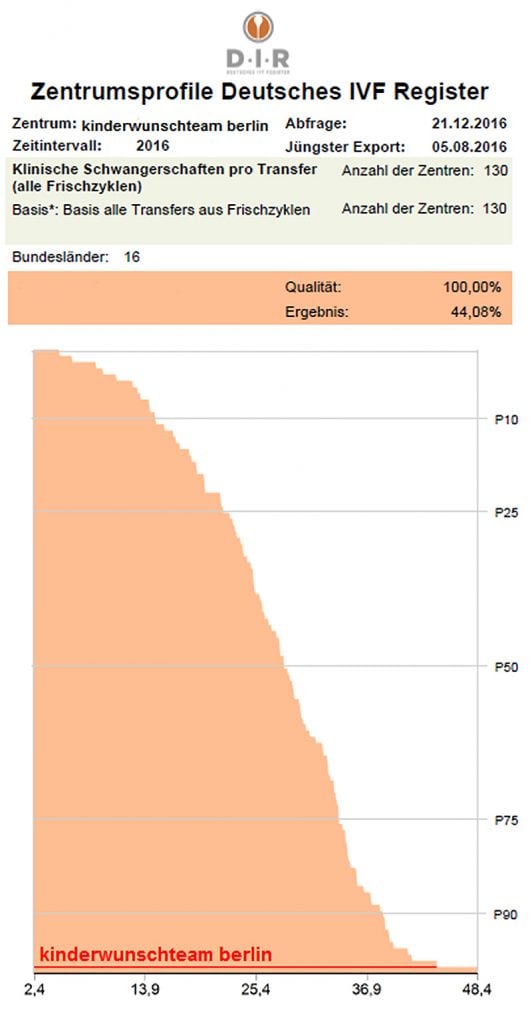Success rates 2016
Statistics / Success rates 2016
We proudly present our pregnancy rates from march 2015 to march 2016 in comparison to the official german figures published by DIR (Deutsches IVF Register, the german central registry) of 2016. The 2017 figures are not available yet. The bottom line indicates the mean number of embryos transferred.

These figures prove the effectiveness of our overall treatment strategy (patient tailored- and soft IVF).
Effects of acupuncture in women undergoing IVF
Effects of acupuncture in women undergoing IVF
NEW YORK (Reuters Health) – Acupuncture may help some women conceive through in-vitro fertilization (IVF), a new analysis of past research concludes. But the true benefit in the real world, if any, remains unclear.
Ten years ago, a study in Germany was the first clinical trial to report that acupuncture seemed to improve pregnancy rates in women undergoing IVF. But since then research has turned up mixed results.
Clinical trials on the issue so far have been small, and often of questionable quality.
So for the new study, reported in the journal Fertility and Sterility, Chinese researchers conducted what's called a meta-analysis -- where researchers combine the results of past studies to try to get an idea of the overall picture.
Dr. Cui Hong Zheng and colleagues at Tongji Medical College pooled the results of 24 small clinical trials testing the effects of acupuncture in women undergoing IVF.
The trials varied widely: Many tested needle acupuncture, some electro-acupuncture and some included laser acupuncture in the mix.
In many trials, IVF patients either received acupuncture or nothing. In others, researchers used a form of "placebo" acupuncture such as applying blunt needles to the skin surface. Some researchers used real needles, but stimulated points not related to fertility, according to traditional medicine.
Zheng's team found that overall, women who had acupuncture had a slightly higher pregnancy rate than women who did not have the therapy -- but no higher birth rate.
Three of those trials also looked at birth rates. Of women who received acupuncture, 35 percent had a baby, compared with 25 percent of women in the control groups.
There's some evidence that needle stimulation may improve blood flow to the uterus. And researchers are looking at whether acupuncture might make the uterine wall more receptive to the embryo.
SOURCE: Amy Norton, New York from Fertility and Sterility, online January 12, 2012.
Dr. Peet, Januar 2012
Cross Border Healthcare
European Directive on Cross Border Healthcare
The Council of the European Union has in February 2011 approved this directive.
Citizens of the UK and other EU member states have a right (in certain circumstances and under certain conditions) to seek treatment in other European states and for the cost of this treatment to be reimbursed by the NHS or the according national health insurance company.
Here is a link to a pdf version of the directive at www.consilium.europa.eu
For further information also see the Website www.treatmentabroad.com with explanations from a UK patients' perspective.
Medical Tourism – new EU directive
Dr Prem, a world renowned Global Healthcare expert and Medical Tourism Consultant, Global Healthcare News & Network:
"The new EU directive allows patients to travel within Europe for medical treatment.
As the NHS comes under pressure to reduce spending, a new guide to patients’ rights under the recently ratified EU Directive on Cross Border healthcare will help patients to explore the options for treatment in another EU state, funded by the NHS. The new EU directive allows patients to travel within Europe for medical treatment. With today’s news reports raising ..."
Read more: Website: Global Healthcare News & Network
. . . . . . .
Single versus double intrauterine insemination
Comparison of the effectiveness of single versus double intrauterine insemination with three different timing regimens
By Dr. Esra Tonguc et al
Objective
To compare double insemination with two different single insemination regimens.
Patient(s)
Four hundred and fifty patients with unexplained infertility, male factor, and ovulatory dysfunction underwent controlled ovarian hyperstimulation with gonadotropin.
Intervention(s)
The patients were divided randomly into three groups: patients in group 1 underwent a single preovulatory intrauterine insemination (IUI) performed 24 hours after hCG administration. Patients in group 2 underwent two IUIs performed 12 and 36 hours after hCG administration. Patients in group 3 underwent a single periovulatory IUI performed 36 hours after hCG administration.
Result(s)
The total pregnancy rate per patient was 14.2 % (64 pregnancies in 450 patients). Group 1 had 17 pregnancies (11.3%), while groups 2 and 3 had 21 (14.0%) and 26 (17.2%) pregnancies, respectively. The difference between the three groups in regard to pregnancy rates was statistically not significant.
Conclusion(s)
Despite the 36th hour being the preferred timing for IUI, there was no difference regarding pregnancy rates between single 24th hour and double 12th- and 36th-hour inseminations. This finding suggests that the 24th-hour IUI might be preferred in demanding situations.
Source:
From Fertility/ Sterility Volume 94, Issue 4, Pages 1267-1270 (September 2010)
Nobel Prize for the father of IVF
Finally! With 30 years delay!
Nobel Prize for the father of IVF
Robert Edwards, the father of ‘in vitro’ fertilization, receives the Nobel Prize for medicine
The British researcher Robert Edwards has been rewarded with the 2010 Nobel Prize for medicine, for his breakthrough in ‘in vitro’ fertilization.
He is getting this prize at 84 years of age, and at over 30 years from conceiving the first child in a tube. At that time it was a real medical revolution, because it made treating sterility possible!
Since then, 4 million children have been born, thanks to ‘in vitro’ fertilization.